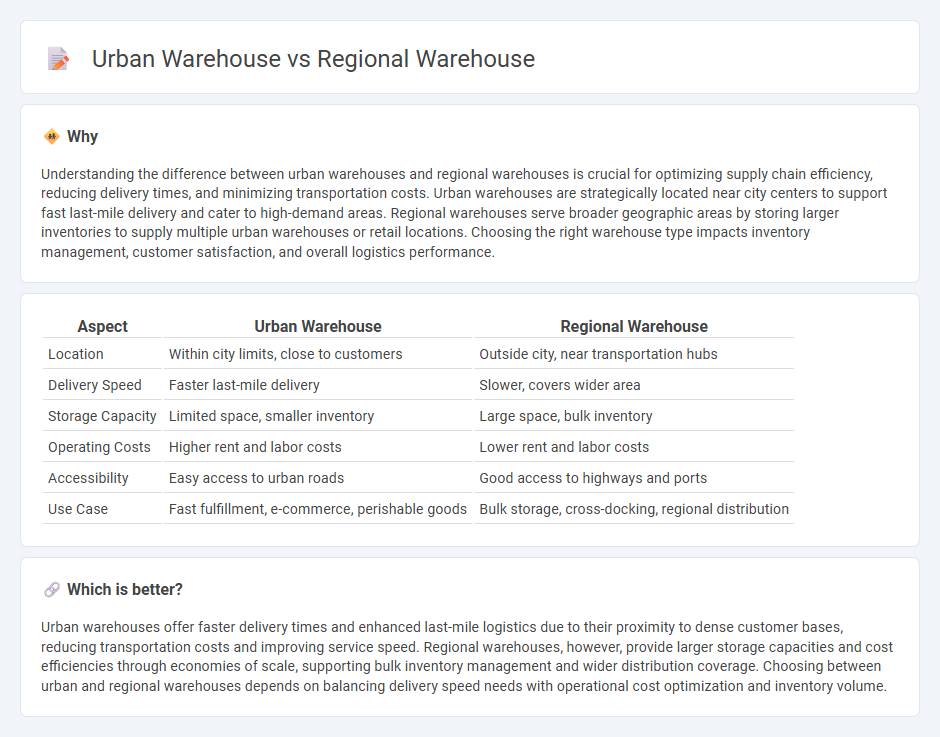
Urban warehouses are strategically located within city limits to enable rapid order fulfillment and last-mile delivery, significantly reducing shipping times and costs. Regional warehouses, positioned on the outskirts or in suburban areas, offer larger storage capacities and support bulk inventory management for broader geographic distribution. Explore the advantages of each warehouse type to optimize your supply chain efficiency.
Why it is important
Understanding the difference between urban warehouses and regional warehouses is crucial for optimizing supply chain efficiency, reducing delivery times, and minimizing transportation costs. Urban warehouses are strategically located near city centers to support fast last-mile delivery and cater to high-demand areas. Regional warehouses serve broader geographic areas by storing larger inventories to supply multiple urban warehouses or retail locations. Choosing the right warehouse type impacts inventory management, customer satisfaction, and overall logistics performance.
Comparison Table
| Aspect | Urban Warehouse | Regional Warehouse |
|---|---|---|
| Location | Within city limits, close to customers | Outside city, near transportation hubs |
| Delivery Speed | Faster last-mile delivery | Slower, covers wider area |
| Storage Capacity | Limited space, smaller inventory | Large space, bulk inventory |
| Operating Costs | Higher rent and labor costs | Lower rent and labor costs |
| Accessibility | Easy access to urban roads | Good access to highways and ports |
| Use Case | Fast fulfillment, e-commerce, perishable goods | Bulk storage, cross-docking, regional distribution |
Which is better?
Urban warehouses offer faster delivery times and enhanced last-mile logistics due to their proximity to dense customer bases, reducing transportation costs and improving service speed. Regional warehouses, however, provide larger storage capacities and cost efficiencies through economies of scale, supporting bulk inventory management and wider distribution coverage. Choosing between urban and regional warehouses depends on balancing delivery speed needs with operational cost optimization and inventory volume.
Connection
Urban warehouses serve as strategic distribution hubs located within densely populated city areas, enabling rapid fulfillment and last-mile delivery. Regional warehouses function as larger storage facilities positioned outside urban centers to hold bulk inventory and replenish urban warehouses efficiently. The connection between urban and regional warehouses optimizes supply chain logistics by balancing inventory availability with proximity to end customers, reducing delivery times and transportation costs.
Key Terms
Distribution Coverage
Regional warehouses cover extensive geographic areas, enabling bulk storage and efficient distribution to multiple urban centers. Urban warehouses focus on last-mile delivery, situated close to densely populated areas to offer faster shipping and improved customer service. Explore the strategic benefits of each warehouse type to optimize your distribution coverage.
Inventory Turnover
Regional warehouses typically hold larger stock volumes, resulting in slower inventory turnover due to extended distribution channels and broader service areas. Urban warehouses, situated closer to end customers, enable faster inventory turnover by facilitating quick replenishment and reducing lead times. Explore effective warehouse strategies to optimize your inventory turnover rates.
Last-Mile Delivery
Regional warehouses serve broad geographic areas and enable efficient bulk storage and distribution, reducing transportation costs over long distances. Urban warehouses, located closer to end consumers within city limits, optimize last-mile delivery by enabling faster, more flexible order fulfillment and reduced delivery times. Explore how choosing between regional and urban warehouses can revolutionize your last-mile delivery strategy.
Source and External Links
Regional warehouse: Supply chain advantages - A regional warehouse serves as a distribution point for a specific geographic region, offering benefits like inventory consolidation and reduced delivery times.
Regional warehouse for smaller distribution zones - A regional warehouse is designed to handle short shipping routes, accommodating numerous vehicles and facilitating real-time inventory management.
What is Regional Warehouse? - A regional warehouse is strategically located to store and distribute goods within a specific region, reducing transportation needs and costs.
 dowidth.com
dowidth.com